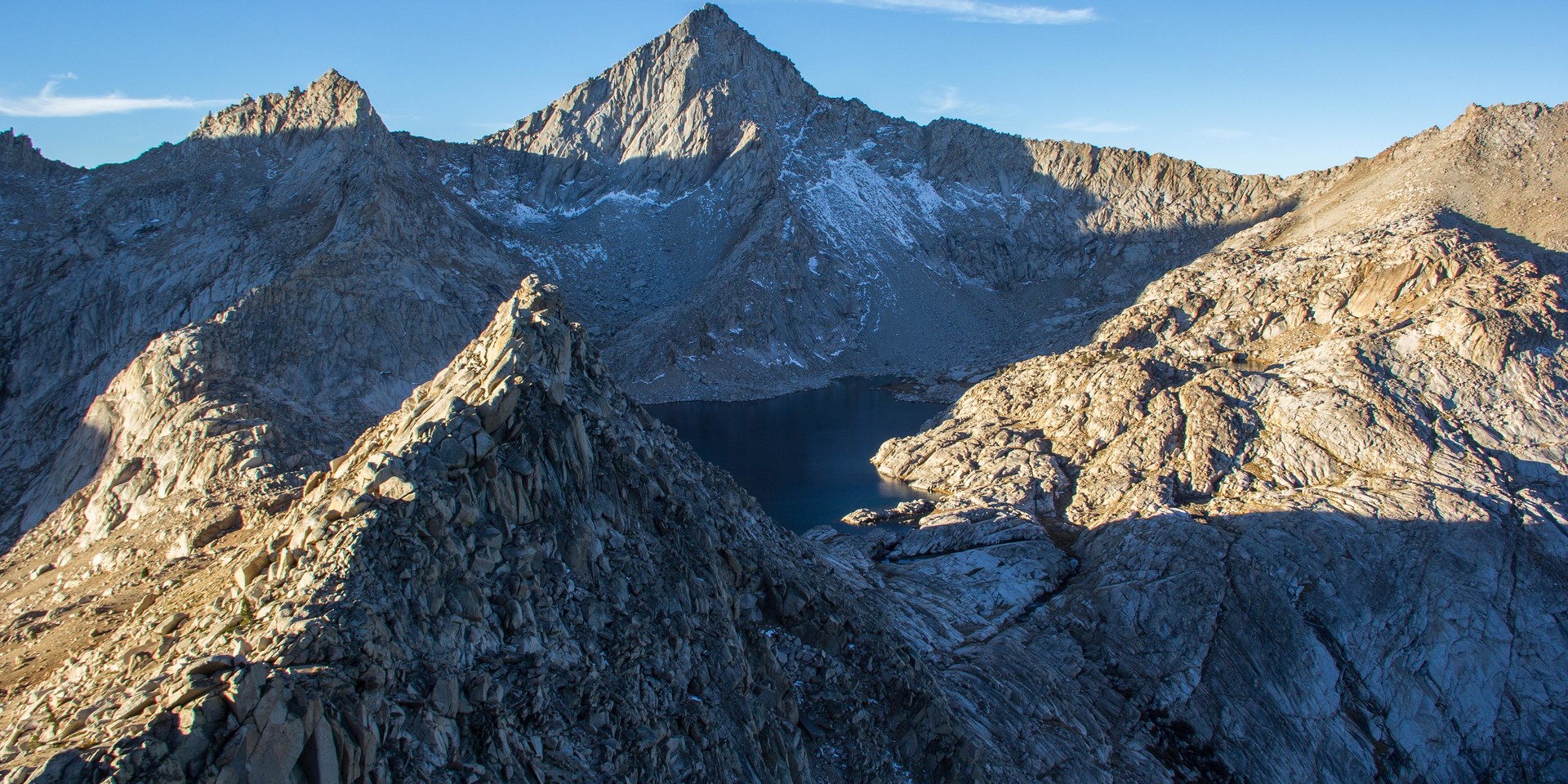You are here
Columbine Lake lies less than 6 miles from the end of the road, but in terms of a rugged location with a remote alpine feel, it couldn't be further away. Columbine’s remote feel is due in part to the lake lying on the east side of 11,630-foot Sawtooth Pass, one of a handful of ridgetop keyholes leading into Sequoia National Park’s expansive backcountry.
Cradled just beyond the Sawtooth Pass saddle high above tree line, Columbine Lake sits in a granite bowl surrounded by a circular ridge of jagged granite peaks. Rising directly above the lake is the shapely serration of 12,343-foot Sawtooth Peak, the tallest peak in the immediate vicinity and a desirable summit among peak baggers. Hanging precipitously over Columbine's southern shore, Sawtooth Peak provides a striking backdrop against the lake's cobalt blue waters.
While the lake itself is beautiful, it’s the surrounding terrain and nearby vistas that truly set the Columbine Lake area apart. From Sawtooth Pass, vistas span from the Great Western Divide’s Kaweah Peaks Ridge to the Mount Whitney ridge. Closer to the lake are vistas overlooking Lost Valley as well as Cyclaman and Spring lakes, which are connected to Columbine Lake in the same drainage.
Columbine Lake is also a common stop for backpackers making their way out of the Sequoia wilderness via Lost Valley as part of longer hikes starting in Mineral King and elsewhere. A trail marked by large cairns leads around the north shore of the lake and connects Lost Valley to Sawooth Pass. Hikers looking to camp at Columbine Lake should camp at least 100 feet away from the lake along the lake’s northern edge among the granite slabs. As with all wilderness areas, please be sure to practice Leave No Trace principles when passing through or camping here.
To reach Columbine Lake, take the Sawtooth Pass Trail located in Mineral King Valley. The trailhead begins at 7,800 feet and climbs steadily over 4.5 miles to Monarch Lakes before continuing up and over Sawtooth Pass. Reaching Columbine Lake, therefore, requires a 3,800-foot slog up and over Sawtooth Pass, a big day by any account.
The section of the Sawtooth Pass Trail beyond Monarch Lakes follows an unmaintained access trail that switchbacks up a steep scree field. Make sure not to confuse Sawtooth Pass with 11,110-foot Glacier Pass, a lesser-used cross-country pass that continues down to Spring Lake, set between the Empire Mountain-Sawtooth Pass Ridgeline, and located west of and approximately 450 feet lower in elevation than Sawtooth Pass.
When approaching from Mineral King, Sawtooth Pass affords the first view of Columbine Lake. From the pass, follow the access trail marked by cairns down to the north shore of the lake.
Some important notes about Mineral King:
• Mineral King road, which provides access to Mineral King Valley, is typically open between the end of May through October. Check the park's road conditions page for status.
• Backcountry permits and bear canisters are required for overnight trips in Sequoia National Park. Both are available at the Mineral King Ranger Station during peak months (June through September). If you are heading out in spring or fall, self-issued permits can be obtained outside the ranger station, and bear canisters can be rented from numerous outdoor gear shops in Visalia, Fresno, and elsewhere. Be prepared to see rangers, as they are out and about on trails.
• Marmots have posed a serious problem for a few unlucky hikers who park their cars at Mineral King trailheads in the late spring and early summer months. They have been known to crawl up into engine compartments and chew on everything from electrical wiring to hoses, disabling some vehicles. This is thought to occur due to a lack of salt content in the Marmot’s natural food source until later in summer, and the threat seems to decrease after mid-July. To avoid this potential issue, either park your car near the ranger station a mile from the Sawtooth Trailhead (marmots seem to stay higher up the valley), or wrap the lower third of your vehicle in a tarp diaper, which helps prevent marmots from climbing into the engine compartment via wheel wells. For the latter method you’ll need a tarp large enough to allow you to drive onto it; you then wrap the tarp above the wheel wells around the entire vehicle. Secure in a diaper fashion with lanyard or rope.
Logistics + Planning
Current Weather: Powered by Dark Sky
























Comments
Interesting note. Columbine Lake is gorgeous. But we ended up setting up camp at the more private and secluded Cyclamen Lake. It's perched above Columbine Lake on the North side. Views are amazing. August was the perfect month. Very hot going over the pass but the weather and meteor showers were unbelievable.
Sign In and share them.